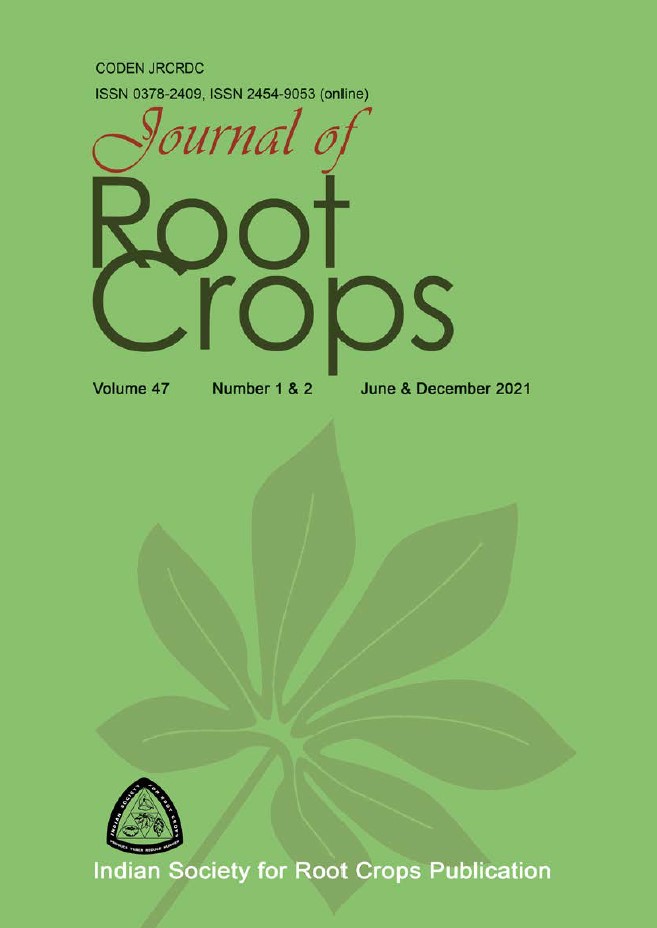Taro (Colocasia esculenta Schott.) based intercropping systems: interspecies interaction effects on growth and yield
Abstract
Intercropping is a viable option to monoculture with a view to increasing the use efficiency of natural resources. A field experiment was conducted at the Regional Station of ICAR-Central Tuber Crops Research Institute, Bhubaneswar, Odisha, India for three consecutive years (2018-2000) on alfisols under rainfed conditions to study interspecies interaction in taro based intercropping systems. The experiment consisted of seven treatments, T1-sole taro, T2-sole maize, T3-sole pigeon pea, T4-taro+maize (5:1), T5- taro+maize (5:2), T6- taro+pigeon pea (5:1) and T7-taro+pigeon pea (5:2). The treatments were replicated three times. During the cropping period, the weather was favourble for all the crops in all the years. The results revealed that taro border rows in intercropping resulted in higher growth characters and lower yield components and yield than sole crop rows. Maize and pigeon pea in intercropping resulted in higher growth characters, yield components and yield than sole maize and pigeon pea. Taro was affected by interspecies interference, whereas interspecies interference was minimalfor maize and pigeonpea under intercropping. As intercrop, pigeon pea affected taro corm and cormel yield more than maize as pigeon pea competed with taro for longer period (165 days) than maize (90 days). Under intercropping, the decrease in taro corm and cormel yield was due to decrease in taro population apart from intercrop (maize/pigeon pea) competition. Taro corm yield per ha wasaffected more than cormel yield per ha under intercropping. The cormel equivalent yield (CEY) of taro sole cropping was higher and comparable to taro+maize (5:1) and taro+pigeon pea (5:1) intercropping systems. However, during unfavourable (lesser rainfall and rainy days) season only the potential of intercropping system will be realized.Downloads
Published
How to Cite
Issue
Section
License
Dear Author(s)
We need your written permission before we can publish your accepted article in the Journal of Root Crops. Please read this form carefully, complete it and palace your signature below. A scanned copy of this form may be mailed to us within two days of receipt of this letter. Our email ID is: isrc_ctcri@yahoo.com or editor_jrc@yahoo.com or sreekumarctcri@gmail.com
Details:
In consideration of the publication in the Journal of Root Crops of our contribution entitled
(Name of the paper): .................................................................................................................
.................................................................................................................................................... by us (all Authors’ names) ..........................................................................................................
....................................................................................................................................................
A. To be filled in if copyright belongs to you
I/we hereby assign to Indian Society for Root Crops, Thiruvananthapuram, India, the full copyright in all forms and media in the said contribution, including open/ restricted access to online version. They own the rights to freely grant or distribute the paper to any third party or public
Please tick this box if you are the sole author of the paper
Please tick this box if you are authorised to execute this copyright transfer on behalf of all the authors of the above article
Name (block letters): . . . . . . . . . . . . . . . . . . . . . . . . . . . . . . . . . . . . . . .......
Institution/Company:..................................................................................................................
....................................................................................................................................................
Signature:.....................................................................; Date: ....................................................
B. To be filled in if copyright does not belong to you
1. Name and address of copyright holder:................................................................................
........................................................................................................................................................................................................................................................................................................
2. The copyright holder hereby grants Indian Society for Root Crops, Thiruvananthapuram, India the full copyright in all forms and media in the said contribution, including open/ restricted access to online version. They own the rights to freely grant or distribute the paper to any third party or public.
(Signature of copyright holder or authorised agent)





